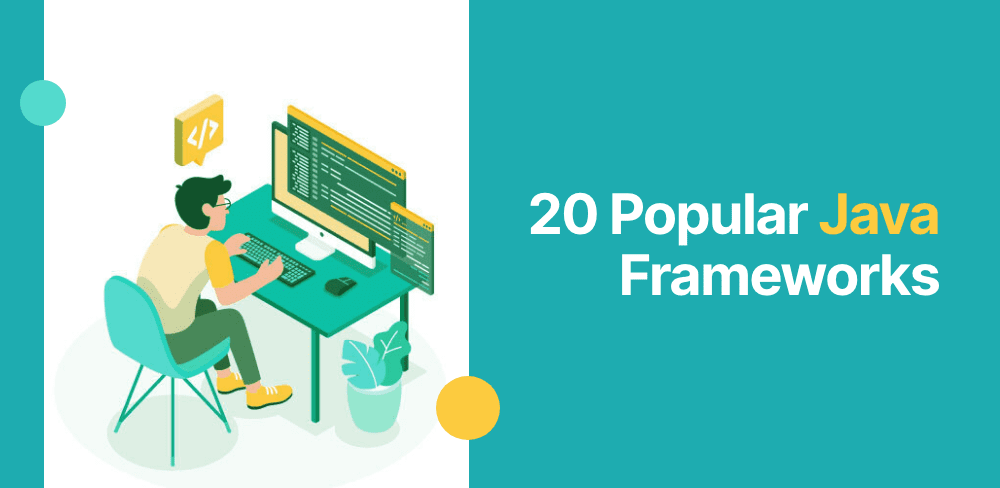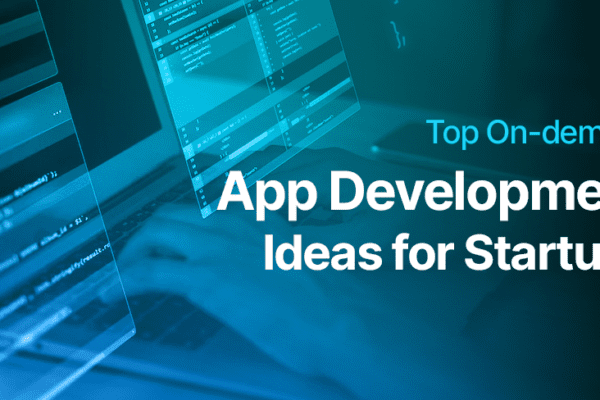Do you know what language is used to write more than fifty million websites, including the most popular ones, such as Google and LinkedIn, eBay, Amazon, and Stack Overflow? Java Frameworks is the most widely used language.
Java has just celebrated its Silver Anniversary but is still leading the software industry regarding “Old Is Gold” reliability. Java’s Allrounder provides numerous applications for Android projects, Cloud Computing, Big Data, and Machine Learning.
Still, when it comes down to Web development, Java is the most suitable choice for all levels of developers. Extensibility is now a top priority for all web developers. Multiple frameworks exist to increase the functionality and flexibility that Java natively offers.
This post will explore the most popular and best Java frameworks. Let’s first explore what the Java framework is.
So let’s begin.
What is the Java Framework?
Java Framework is an application platform that contains pre-written code. Java developers use it to build Java web applications. It is used as a template by developers to create Java programs and software applications.
Developers can build a program using the Framework rather than starting from the beginning with the manual. It contains predefined classes and functions that can be used to manage and process hardware devices and communicate with the system software. The type of Framework, the program that produces the output, and preferences all play a role in this.
Why Use Frameworks?
It takes a long time to create complex Java applications. Adding a framework simplifies the process. Many common features are required by almost all applications, such as data retrieval, privacy, and security.
Many of these features are included in the best Java frameworks, so you don’t need to reinvent them every time you create a new application. These frameworks also offer a software structure that will help you build a well-structured app. These frameworks are actively developed, so you can be sure that the Java code is updated regularly and tested.
You can hire software developers who know both Java and the Framework that you use to expand your team. The majority of Java frameworks come with their very own ecosystem. This includes documentation, learning material, support forums, social media channels, and more. These can be extremely helpful and facilitate the development process.
Top 20 Java Frameworks for 2023
Here are the 20 best Java frameworks that are widely used for developing applications by developers. So let’s have a look:
1. Spring
Spring is the most popular Java framework due to its wide range of applications that focus on simplicity and productivity, and speed. Spring’s modularity allows developers the flexibility to use its tools at every stage of their project.
Spring also interacts with many security features and tools. The Framework allows developers to integrate features such as login validation and authentication of users, which ensures optimal security for both the app and the user data.
These features are easy to use and reliable, which has attracted the attention of many enterprise-level businesses, such as Netflix, Dick’s Sporting Goods, and eBay. Developers of smaller projects also find that it is capable of producing powerful and consistent performances.
2. Google Web Toolkit(GWT)
Google Web Toolkit Framework (GWT), like many other Google open-source releases, quickly became a favorite among developers. GWT is designed to translate Java code into JavaScript, allowing developers to build complex and efficient web applications. Java developers are able to exercise more creativity by converting their Java code into JavaScript.
The size and breadth the open-source community has amassed have also resulted in a library with helpful resources and support information for GWT.
GWT’s ability to scale applications quickly and reliably is a great asset for large-scale, complex applications. This is the rationale for the choice of Java and GWT as the base for iKnowMed, an electronic health records system for sizable cancer practices.
3. Hibernate
Hibernate, an Object Relational Mapping framework (ORM), helps developers to work safely and responsibly with data. This Framework creates robust relational databases that prevent vulnerabilities caused by mishandled data. Its ability to manipulate data powerfully without a lot of code is appreciated by developers.
Hibernate, like GWT, is an open-source project that enjoys a large community of support. It is most suitable for projects that heavily rely on data manipulation, dense databases, and complex database structures. Hibernate is used by many large companies because it can handle data-intensive workloads.
Verify Governance, a sophisticated user access and analytics program from IBM Security that depends on pin-point precision and business-grade data security, is one example of how the Hibernate Framework is used in this context.
4. Struts
Apache is the largest open-source organization in the world. It has created multiple development tools. Struts, a model-view-controller (MVC) framework for building reliable web applications, is one such technology. Struts, a popular Java framework for web application development, is just one of the many available. This Framework is unique in that it prioritizes convenience and includes a growing library of plug-ins.
Due to its flexibility, Struts is a great complement to other frameworks. Struts is a great addition to many web development scenarios. Struts’ versatility allows developers to use it to create anything from simple portfolio sites to feature-rich apps that require highly secure information security and user validation measures.
Struts have several versions throughout their development cycle. Struts 2 is the most popular version, but Struts 6.0.3 is the latest version.
5. Play
Play is a web application development framework open source that puts the user’s experience first. It is licensed under Apache License 2.0 and requires minimal overhead. To begin development, hire java developers who need only a web browser and a text editor. Play is compatible with NoSQL databases and plug-ins, which makes it an excellent option for mobile app development.
Play, like Struts, can handle projects of any complexity and size. This is evident by its use of applications from Samsung, Walmart, and LinkedIn. The play offers extensive support for cloud-based deployments, including AWS. This ensures that apps are consistent, modern, and manageable.
6. Grails
Grails is a web development framework written in Groovy that heavily utilizes the Java Virtual Machine. Grails, like Play, are licensed under Apache License 2.0. It promises to have a minimal learning curve, allowing a Java developer with moderate experience to use its tools immediately. Grails are built upon Spring Boot which gives access to Spring features such as dependency injection.
Companies like Target, Best Buy, and Netflix use Grails because of its relative simplicity and reliability. It is also a great tool for creating RESTful web applications, which take advantage of efficient and modern API calls.
7. JavaServer Faces
A JavaServer Framework for making contemporary user interfaces is called JavaServer Faces. JSF allows developers to build web applications that include multi-purpose UI components. These components can be easily connected to data or client events.
This Framework is not only for front-end designers but also for back-end developers. JSF eliminates issues caused by front-end code on back-end functionality. A different MVC framework, JSF, enables programmers to design “faces” for Java applications. This helps them focus on the functionality of their Java application.
JSF is also supported by a large community and has been integrated into the Java language. This Framework is great when you hire dedicated developers who want to build complex applications with code or integrate a front-end workflow.
8. Blade
The Blade is an independent Java framework that is known for its simplicity, productivity, and speed. This instrument was designed to create a framework that would be so simple to use and learn that it could be used successfully in just one day. The blade does not take up a lot of space or resources. Blade’s focus is to keep data private with its powerful security features.
Its high flexibility allows it to work with many plug-in extensions. Blade’s main advantage is its ease of use, thanks to its simple syntax, which allows people of all technical backgrounds to learn it quickly. Modularity and clear, concise coding are also important features. Users can select components according to their own discretion.
9. Dropwizard
Dropwizard can be used as a Java framework or library. It is a portable tool. Because of its productivity, dependability, and quickness, coders favor it. It helps programmers concentrate on their tasks and achieve their goals faster. This Framework has tools that facilitate the configuration and performance of a system. It is designed to provide the stability required to get an app ready for production.
These robust features make it easy to quickly and efficiently create an application that’s ready for service. Many developers believe that this Framework is especially useful for building Java microservices. It is a very user-friendly framework because it is easy to learn if you are familiar with Java and its logic.
10. Micronaut Java
The Micronaut Java Framework reduces the amount of memory required by programs to run. This Framework is top-notch and allows for the creation of microservices to be done quickly and easily. It is used primarily in the development of microservices and has features such as reduced memory and improved start-up time.
The compiling phase computes features that are usually added during the runtime. You can improve your product’s quality by using the built-in testing options. Micronaut also offers some innovative features that are not found in other Java frameworks. You will also find that Micronaut offers first-class support for reactive software programming, both on the client and server side.
Its other valuable features make this the ideal tool for building an amazing application. This is especially true in the area of Java native cloud computing. It also supports several service discovery tools and works well with distributed request tracking tools.
11. Quarkus
Quarkus was designed for optimization and compiling. It allows for automatic resource generation, including the creation and deployment of images, without the need to manually create files. Quarkus allows Java developers to create great cloud applications. Its goal is to provide engineers with a framework that works well with various application architectures. It is open-source and welcomes contributions to make it more functional.
Quarkus also offers a trouble-free coding experience thanks to its robust libraries, add-ons, and instruments. It is a native Kubernetes-based solution that allows users to deploy their applications without diving deep into all of the platform’s complexities. It is a user-friendly Java Framework that leverages a number of popular libraries. It also combines imperative and reactive coding to make it highly adaptable for any developer.
12. Jakarta Faces
The well-known Framework Jakarta Faces enables you to create user interfaces for Java-based web applications. Jakarta Faces is a stable and reliable Java framework, as the first version was released in 2004.
It is based on a component architecture and follows the MVC design pattern. Jakarta Faces allows you to build user interfaces using reusable components. You can also manage your components’ state, connect them to their data sources and bind events generated by users to server-side event handlers.
Facelets is the default templating system for Jakarta Faces. It was specifically designed for this Framework. Facelets allows you to use XML for handling views instead of Java. You can create views using other technologies, such as XUL and Java. Jakarta Faces web applications are portable between different Jakarta EE application servers.
13. JHipster
JHipster combines Spring Boot with popular frontend frameworks like Vue, Angular, and React into a single web application generator. It is used by well-known companies, including Adobe, Siemens Bosch, HBO, and Google. JHipster allows you to build modern Java-based microservices and web applications quickly.
Spring Boot lets you create Spring-based production applications with minimal configuration. JHipster gives you a complete stack architecture by fusing Angular with React, Vue, and Bootstrap. Check out the JHipster sample apps created for Angular React and Vue to see what a JHipster application looks like in reality.
JHipster allows you to choose from two different architectural styles. You can choose a monolithic application where the front end and backend are combined. You can also choose a microservice architecture, which separates the front end from the back end. JHipster integrates with many tools and provides many options, including client- and server-side coding and bundling.
14. PrimeFaces
PrimeFaces, a popular framework for web development, is used to create lightweight user interfaces that can be integrated into Jakarta EE or Jakarta Faces. It is employed by several Fortune 500 corporations, academic institutions, and governmental organizations.
PrimeFaces is a lightweight library.
PrimeFaces is packaged in a single JAR, does not require any configuration, and has no dependencies. You can create an interface for your Java app with the help of a set of rich components, a skinning framework, and pre-designed layouts and themes. PrimeFaces inherits Jakarta Faces’ features, such as the rapid development of applications. The Framework can be added to any Java project.
PrimeFaces’ website has a great showcase of PrimeFaces templates, themes, and components. These components include relevant code snippets that you can copy/paste directly into your app or modify as needed. Here’s an example of a horizontal mega-menu that allows you to display all submenus for a root menu in a single group.
15. Spark Framework
Spark Framework is a microframework for Java and Kotlin. Kotlin is fully interoperable with Java and runs on the Java Virtual Machine. You may create REST APIs and Java-based microservices with the tool Spark. Micro frameworks were initially developed in scripting languages like PHP or Ruby.
They quickly gained popularity due to their emphasis on speed and simplicity. Spark was inspired by the Sinatra Ruby web application framework. It was originally made available in 2011. It is not an MVC Framework — it allows you to structure your app however you like. Spark is a micro framework that has a minimal code base and requires little configuration. It also doesn’t ask you to write boilerplate code.
Spark Framework can be installed and run in just minutes. It runs by default on the embedded Jetty web server. You can also use it with any other Java web server. Spark’s survey shows that over half of its users use the Framework to build REST APIs. This is by far its most popular application. Spark powers web applications that serve more than 10,000 daily users.
16. MicroProfile
MicroProfile is a set of community-based specifications that helps Java software developers build architectures for cloud-native microservices. The main application area for its implementation is enterprise apps. It is also used to improve both implementations and components continuously.
MicroProfile allows engineers to collaborate and innovate based on their shared interests. It contains several technologies and APIs which are essential for the effective delivery of an application across multiple runtimes. MicroProfile’s main advantages are centered on its ability to cover all needs for typical enterprise-level Java applications, including checking health conditions and metrics.
When it comes to creating microservices, MicroProfile is unquestionably superior to Spring Boot. MicroProfile, although not as popular in the software community, makes cloud infrastructure development easier because it offers discoverability, fault tolerability, and increased security. Spring Boot can’t boast these features. MicroProfile continues to gain momentum despite the widespread adoption of cloud computing by businesses.
17. Vaadin
Vaadin is a modern open-source web framework for Java that allows developers to create a great experience with minimum effort. The Framework comes with a library that includes UI components designed for desktop and mobile. This Framework allows users to create UIs in 100% Java, without HTML, CSS, or JS.
Vaadin allows Java Virtual Machine (JVM) to access the DOM directly. Its apps are run on the server, and all communications are automatically secured. Vaadin uses a Java ecosystem that includes libraries, IDEs, and tools.
18. Wicket
Wicket, another Java-based web framework focusing on components, prioritizes creating web interfaces that are easier to use with the aid of specific patterns. Wicket has technical features that allow components to retrieve data and convert and store it upon receiving events. Lightweight, it allows for quick and easy application development. It is considered a fast and easy option that also offers great security features.
What else makes Wicket such a powerful tool? Since the code is open-source, you are free to alter and expand it as you see fit. If you discover that a solution out-of-the-box doesn’t meet your needs, you can customize it. Wicket can also conduct unit tests for the frontend with only Java code and without requiring additional libraries.
19. Tapestry
Tapestry is a component-based Java Framework that allows you to create scalable web apps. Its architecture is comparable to that of Apache Wicket and Jakarta Faces since it places a strong emphasis on reusable components. Tapestry, like Struts and Wicket, is also an Apache Software Foundation project.
In addition to Hibernate and Spring, Tapestry supports the programming languages Groovy and Scala. Tapestry supports Groovy, Scala, and other Java frameworks like Hibernate or Spring. Tapestry was built for performance. It includes features like live class reloading and exception reporting.
Tapestry also has a developer-friendly environment. It comes with Selenium support and has utilities built in to help facilitate test-driven design (TDD).
20. Vert.x
Vert.x, a polyglot Java Virtual Machine framework, is an open-source project. You can write applications in languages like Java, JavaScript, Groovy Scala, and Kotlin. The event-driven architecture allows applications to scale well even when using minimal hardware resources.
The Eclipse Foundation is responsible for the development and maintenance of Vert.x.
The ‘x” in Vert.x is a reference to its polyglottic feature, which means that you can write code in multiple languages. It offers idiomatic APIs in every supported programming language.
Vert.x, as an event-driven framework that is non-blocking, can handle a large number of concurrent processes with a minimum of threads.
Vert.x’s core framework is only 650 KB in size. The modular architecture allows you only to use the modules that you need, so your app will be as sleek as possible. Vert.x allows you to create lightweight and highly scalable microservices.
Conclusion
You can choose from any of the top Java frameworks to create a reliable and amazing web application. These will meet your company’s requirements and provide you with a high degree of performance and security. The right frameworks make web development more fun. However, you can even take help from a java development company who have expertise in Java Frameworks, which will develop a robust application. Choose your Framework carefully to take advantage of all Java’s features.
FAQ
1. What is the Most Popular and Widely Used Java Framework?
Spring is the Framework of choice for Java developers because it offers a wide variety of applications, emphasizes speed, simplicity, and productivity, and has a large number. Due to its modularity and ease of use, Spring’s tools can be used at any stage of the project.
2. What Java Framework is Simple and Convenient?
Google Web Toolkit has been a popular framework for programmers. The open-source community widely uses the GWT framework, and many apps are developed using it because of its easy integration.











